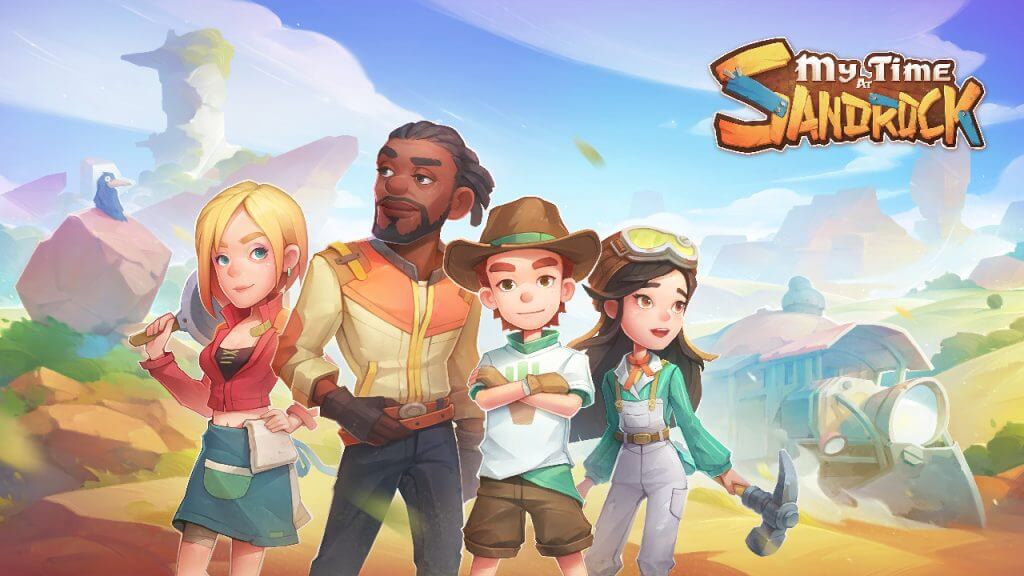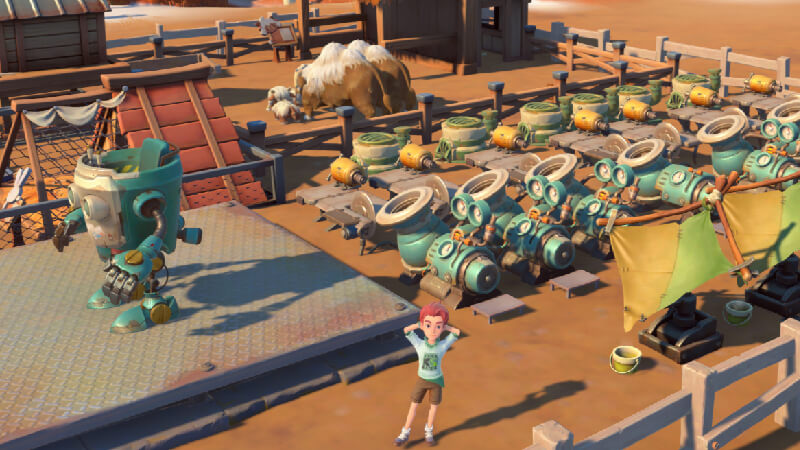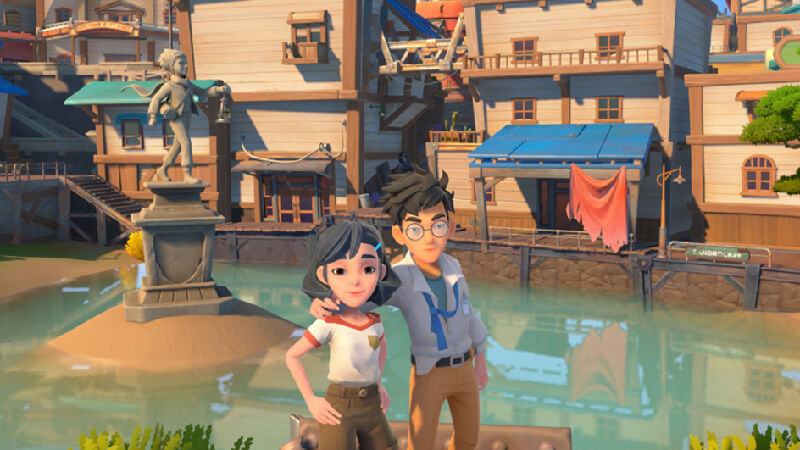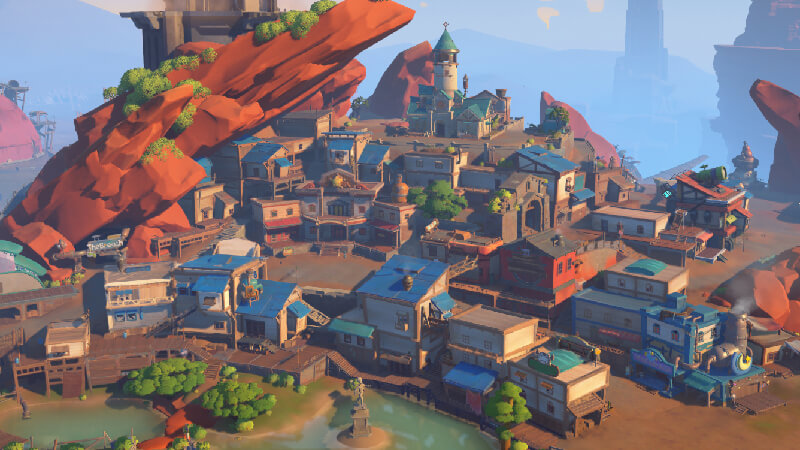Fast Links
Around one year ago, I enthusiastically played Pathea Games’ My Time at Portia until I was completely and utterly satisfied. After playing it for over 200 hours, I realized how impactful these Life-Farming Sim games have been on my gaming interests. Once I heard about the release of My Time at Sandrock, I was worried but intrigued by what the sequel would bring to the table after my wondrous experience with the previous game. Throughout this review, I’ll highlight some of the most noteworthy changes My Time at Sandrock made and whether the Early Access version of the game is heading in an optimistic, promising direction.
Story: Building in a Sandy, Post-Apocalyptic World
The My Time series takes place in a post-apocalyptic world 300 years after what’s known as the “Day of Calamity.” While My Time at Portia takes place in a colorful, small town by the same name, Sandrock is a desert settlement looking to raise its tourism attraction. Throughout your My Time at Sandrock adventures, you play the role of an aspiring builder who recently moved into the quaint town. After moving into a new workshop, you take on the part of completing town commissions and various side quests for Sandrock’s residents while helping to improve the town. As you socialize with the other residents of Sandrock, you learn more about the world and your surroundings.
All the while, one of your primary goals is to stay environmentally friendly, particularly by conserving water and recycling scrap resources in exchange for building parts. These factors all play a role in the general attitude of the town’s inhabitants about the importance of farming, collecting water, and working together in times of distress, which is further emphasized throughout the main story questline.
Gameplay: Always Busy
While Portia housed similar environmentally friendly themes, My Time at Sandrock further embraces that core focus through several new mechanics. Most notably, a vast amount of your resources come directly from recycled materials to the point of penalization if you begin chopping down trees for wood. Anyone who’s played the previous entry knows this is a far cry from its focus, though it serves to diversify gameplay and feels far more organic as a result.
There were also some fresh variations to the player-character relationship system, which some could argue needed some freshening up. In case you’re unfamiliar, the relationship system lets you complete side quests for various characters to improve your friendship with them. Choose to go further and complete commissions alongside giving gifts, and you’ll have a shot at starting a relationship with them. Portia did enough to make the system serviceable, though it felt underbaked due to its somewhat robotic nature. Sandrock opts to give some additional, exclusive dialogue as a cherry on top, giving more reason to explore these options than before.
It wasn’t just in these areas either that we saw improvements. Another major cornerstone that My Time at Sandrock seeks to reinvigorate is in its combat. Where Portia may have felt monotonous for some, Sandrock encourages you to shake up your arsenal and use all tools at your disposal. Rather than primarily using one or two weapon types in Portia, My Time at Sandrock introduces several that serve different purposes. Sandrock also strives to separate itself from the spam-clicking nature that far too many combat systems, including My Time at Portia, have by introducing defense-breaking mechanics and improved dodging. As a result of all these changes, My Time at Sandrock’s combat feels similar yet refreshing in a way not many likely expected.
Still Needs Some Polishing
Despite me singing my praises for Sandrock’s gameplay mechanics, being an Early Access game, there are a few rough edges that could use polishing. A major issue I noticed early on was in loading times. It doesn’t take eons to finally get in-game, though it could take upwards of 3-4 minutes which may deter some. Performance issues also affected the experience, mainly through stuttering when entering and exiting buildings. It wasn’t a game-breaking issue by any stretch of the imagination, though when trying to get to shops quickly before they closed, it was understandably a tad frustrating.
Another issue came in horse-riding mechanics, though not in the sense you may think. Riding your horse through the town of Sandrock generally doesn’t house many issues, though, with cutscenes rendered in-engine, the horse would often impede certain character movements and soft-lock the cutscenes, with some cutscenes also not skippable. The only solution would be to reload, leave my horse far away from the cutscene location, and then go through it again. Thankfully, it wasn’t a problem that happened a ton, but it was enough to be an annoyance.
Graphics and Audio: Energizing Yet Calming Atmosphere
While many would praise some games for realistic graphics or award-winning soundtracks, you won’t find this in My Time at Sandrock. Instead, the game’s charm comes from its colorful, cartoonish art style. Despite maintaining consistency with its art throughout both games, Sandrock has considerably more polished, refined graphics compared to Portia. The UI is also attractive and easy to understand, reminiscent of Portia’s without being a direct copy. While I did observe occasional translation errors with some pop-up messages, it was usually during situations where I had enough context to understand what was going on. Overall, My Time at Sandrock’s art remains another considerable improvement to Portia’s that had me smiling the entire way through.
Likewise, the game’s music switches between a calming, atmospheric soundtrack befitting a small desert town and uplifting songs to get you in the mood to start a new day. Different music plays depending on the time of day and your location, giving appreciable variety to the environment. The main issue currently is a lack of voice acting. While this is officially planned for the future, it is odd to watch scenes that intend to have voice acting but don’t.
Conclusion: Learning From the Past
In its Early Access, my Time at Sandrock proves that it can potentially surpass My Time at Portia to make an incredible experience. Not only does it provide plenty for newcomers to the series, but it proves itself as an excellent sequel that innovates on past mechanics while still holding true to form. Above all else, though, Pathea Games took criticism of Portia under consideration and ensured critics had their quarrels handled appropriately. With 30 hours already clocked in and many more sure to come, My Time at Sandrock’s Early Access is far from a rocky start.
If you are interested in learning more about the game after reading this review, My Time at Sandrock Early Access is available starting May 26, 2022, on PC through Steam and the Epic Games Store. You can also find more information about the developer of My Time at Portia and My Time at Sandrock, Pathea Games, from their official website and My Time at Sandrock information page.
[review]




